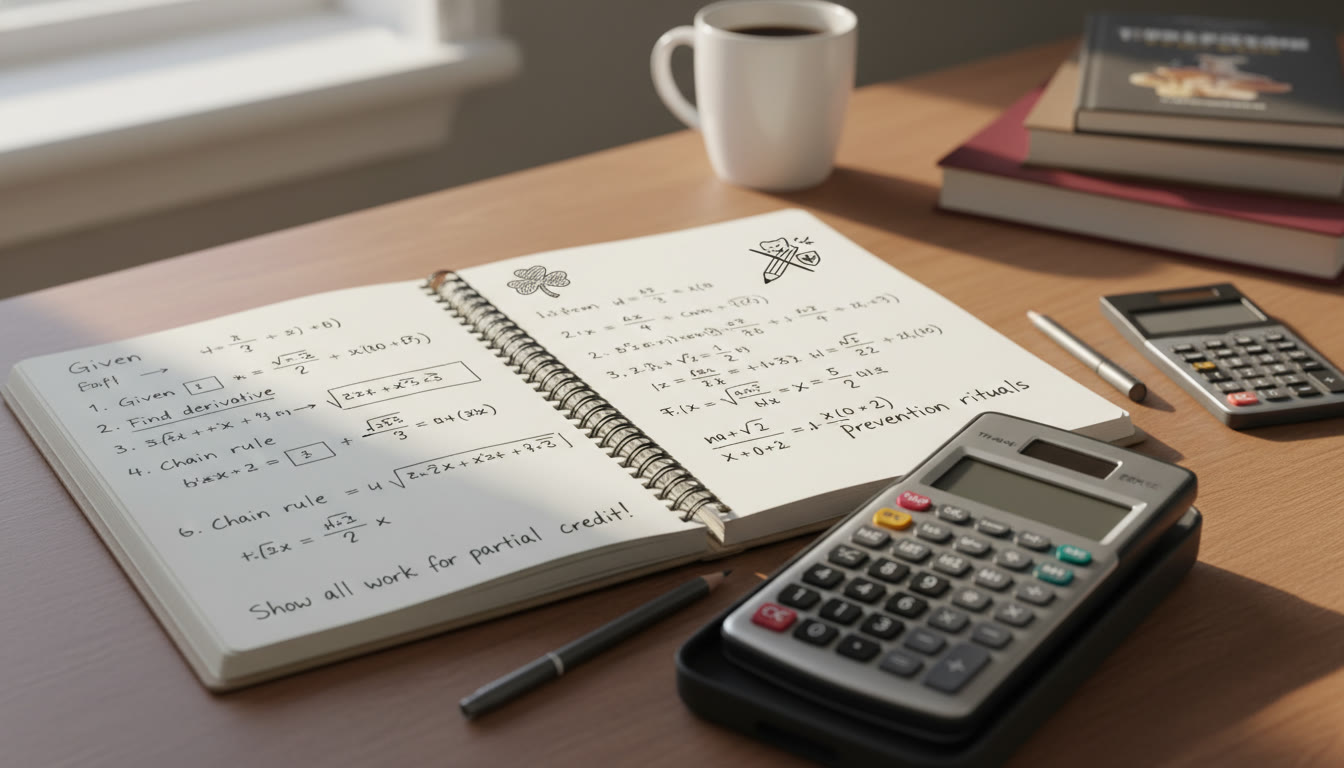What If Your Calculator Fails? Why This Question Matters
Picture this: you’re midway through a free-response question on an AP exam—maybe Calculus AB, Chemistry, or Physics—and your calculator flickers, freezes, or dies. Your chest tightens, time is ticking, and all of a sudden the math looks taller than it did five minutes ago. It’s a real scenario that every AP student should plan for, not to be paranoid but to be prepared.
This post is for students who want to turn a potential meltdown into a manageable hiccup. I’ll walk you through practical, tested strategies for staying calm, finishing the test, and maximizing your score even if a calculator fails. Along the way you’ll get quick mental math tools, procedural steps for exam-day problems, a compact checklist you can print, and a few study habits that make a stuck moment far less scary—things tutors (including Sparkl’s personalized tutors) often emphasize in 1-on-1 coaching.
First Things First: Know the Rules
Before exam day, know the College Board calculator policy for your course. Not all AP exams allow calculators, and for those that do, there are rules about models and features. The big takeaways to memorize:
- Some AP exams require a graphing calculator for specific parts (e.g., Calculus AB/BC parts where the calculator is required); other exams allow calculators only on certain sections.
- Bluebook (the digital testing app) often includes built-in Desmos calculators for many exams—learn its layout beforehand if you’ll be using it.
- Not allowed: phones, smartwatches, calculators with internet or QWERTY, or unapproved touchscreen models unless explicitly on the approved list or allowed by accommodations.
Why this matters: if your calculator fails but the exam includes an integrated Desmos tool or you have a second allowed calculator, your path forward changes. Preparation lowers uncertainty.

Exam-Day Fail: A Simple Step-by-Step Game Plan
If your calculator fails during the exam, breathe. Follow this short sequence to protect time and your score.
1. Pause and assess (10–20 seconds)
- Are you seeing an error message, a black screen, or frozen buttons? A quick look will tell you whether it’s a battery issue, a software freeze, or something else.
- If it’s a frozen screen, sometimes removing/replacing the batteries or pressing the reset button (if allowed and reachable) will work. But don’t spend more than 20–30 seconds fiddling.
2. Flag the question and move on (30–60 seconds)
Circle or mark the question on your test. If it’s multiple choice, move to the next item. If it’s free response, jot a quick plan: what you were going to compute and what the final expression should look like. That way, when you come back you won’t have to reconstruct everything from scratch.
3. Ask the proctor (30–90 seconds)
- Raise your hand and calmly tell the proctor your calculator isn’t working. They will follow the testing site rules—sometimes they have spare approved calculators; sometimes they can’t provide one (depending on the exam administration and policies).
- If a spare calculator is provided, check whether its model and functions match what you need (e.g., graphing vs. scientific). If it’s unfamiliar, request a moment to get comfortable—then proceed with your marked questions.
4. Use alternate tools or methods
If no replacement is available, switch to non-calculator strategies: algebraic simplification, estimation, unit analysis, and structured arithmetic (long multiplication or fraction operations). Many free-response parts accept algebraic work even if the numeric computation is simplified—show your process clearly.
Quick Mental Math and Problem-Solving Tricks That Save Time
Having a handful of fast mental tools is like a secret weapon. Practice these so they feel natural under pressure.
- Break numbers apart: Multiply 1.25 × 48 by thinking 1.25 as 5/4: (5 × 48) / 4 = 240 / 4 = 60.
- Use factoring: Instead of calculating 1024 × 97, do 1024 × (100 − 3) = 102400 − 3072 = 99,328.
- Estimate with bounds: If an exact value is messy, compute lower and upper bounds. Many multiple-choice questions are robust to tight estimates that identify the correct choice.
- Logically check units and magnitude: If your computed velocity is 10^9 meters per second, something’s wrong—units and rough scale catch mistakes fast.
- Use common conversions and identity knowledge: Memorize squares, cubes, trig values at common angles, and powers of 10 for quick recall.
These tricks won’t replace a calculator for lengthy computations, but they’re enough to salvage many items—especially if you combine them with clear, structured written work that earns partial credit on free-response questions.
When You Have to Do Paper Arithmetic: A Compact Table of Speed Methods
Here’s a small table you can copy into a one-page cheat-sheet (for practice only) to train speed arithmetic techniques. Practicing these so they become reflexive will pay off on exam day.
| Operation | Technique | Quick Example |
|---|---|---|
| Multiplication | Split and distribute | 23 × 47 = 23 × (50 − 3) = 1150 − 69 = 1081 |
| Division | Factor numerator and denominator, reduce first | 126 ÷ 14 = (9 × 14) ÷ 14 = 9 |
| Square roots | Use perfect-square factoring | √180 = √(36 × 5) = 6√5 |
| Percent | Convert to fractions for clarity | 8% of 225 = 0.08 × 225 = (8/100) × 225 = 18 |
| Trigonometry | Use exact values for common angles | sin 30° = 1/2, cos 45° = √2/2 |
Free-Response: Write for Partial Credit
AP graders award partial credit for correct setup, clear reasoning, and correct intermediate steps—even if your final arithmetic is off. If your calculator dies, do the following on free-response problems:
- Start with a one-line summary of your approach (e.g., “We will isolate x by applying the quadratic formula” or “Compute net force = sum of component forces”).
- Show algebraic steps clearly. If you simplify symbolically instead of plugging numbers, graders can often follow your logic and award points.
- If you must estimate, provide bounds and state them explicitly (“approximate to two significant figures” or “I will estimate by replacing 3.1416 with 3.14”).
Practice this style regularly. Tutors like those at Sparkl emphasize showing work and structuring responses so that even an imperfect numerical answer reflects solid understanding.
Multiple-Choice: Smart Elimination Without a Calculator
Multiple-choice problems often have answer choices that make elimination efficient:
- Compare scales: If a choice is many orders of magnitude away from your rough estimate, eliminate it.
- Plug in easy numbers: For algebraic expressions, substitute small integers to test options quickly.
- Use parity and divisibility: If choices disagree on whether a number is even/odd or divisible by 3, divisibility tests are quick to apply by hand.
Practice Scenarios You Should Simulate
The day before a big exam is not the time to find out you can’t do long division under pressure. Simulate these failure scenarios to build mental confidence:
- Do a timed section without any calculator—practice questions that are normally calculator-allowed.
- Switch calculators in the middle of a practice test to simulate adjusting to a new layout or button mapping.
- Practice showing neat, organized work for partial credit in free-response problems.
Working with a tutor for targeted practice—Sparkl’s 1-on-1 tutoring can create tailored practice plans that simulate calculator failure and guide you through step-by-step recovery strategies—speeds up this learning dramatically.
Prevention: Reduce the Chance of Failure
Prevention is a far better strategy than recovery. Here are simple, high-impact precautions you should take in the days and hours before the test:
- Bring two approved calculators. One as your primary and one as a backup—different brands can be helpful so you’re not surprised by identical quirks.
- Use fresh batteries (even if it seems overkill). Consider bringing a small battery pack and spare batteries in the case, labeled and sealed in a clear bag to hand the proctor if needed.
- Familiarize yourself with Bluebook’s built-in Desmos tools if your exam offers them—know where the buttons are and how to switch between graphing and scientific modes.
- Do several timed practice sessions with each calculator you might use so button locations are muscle memory.
- Carry a small, well-organized test kit: pencils, erasers, an approved calculator, a second permitted calculator, a ruler, and a spare set of batteries.
When Nothing Works: The Psychology of Staying Calm
Even if you’ve prepared perfectly, the emotional hit of a tech failure can steal minutes. Managing your emotions is part of the strategy.
- Use a two-breath reset: inhale for four counts, exhale for six. It lowers your heart rate and tightens focus.
- Keep language matter-of-fact: tell yourself, “This is a solvable problem.” Replace catastrophizing (“I’ll fail the class”) with process statements (“I’ll mark and move on, then come back.”).
- Use the time you’d spend panicking to write a one-line plan next to the question—this often yields better returns than more frantic calculations.

Sparkl’s Role: How Targeted Tutoring Makes Failures Smaller
Personalized tutoring helps in three concrete ways:
- Practice under realistic constraints—your tutor can simulate a dead calculator, a switch to a different model, or a digital Desmos-only environment so you’re never surprised.
- Tailored study plans—Sparkl’s 1-on-1 guidance can focus on weak points (e.g., algebraic manipulation, statistics computations without tech) and give AI-driven insights on which practice problems yield the most score improvement.
- Confidence-building—having a coach walk you through recovery techniques makes you calmer and more likely to earn partial credit when something goes wrong.
These benefits aren’t just promotionalideals; they directly translate to faster recovery on exam day and steadier performance under pressure.
Common Myths and Reality Checks
Let’s clear up a few myths students repeat:
- Myth: “If my calculator dies, I’ll lose all my points.” Reality: Clear work and partial credit often compensates for missing final arithmetic.
- Myth: “I must memorize every constant and formula.” Reality: Memorizing core constants and common values helps, but strategy and showing work matter more for many free-response items.
- Myth: “Proctors will always have a calculator spare.” Reality: Some centers do, some don’t—so bring backups when possible and practice non-calculator skills.
Printable One-Page Emergency Checklist (Memorize or Carry)
Here’s a compressible checklist you can memorize or write on a corner of your scratch sheet before testing (if permitted):
- Mark the problem and move on.
- Raise your hand and calmly describe the issue to the proctor.
- If replacement provided, test basic functions and adjust; if not, show all algebraic steps and use estimation.
- Use two deep breaths, then write a 1–2 line plan for the question you left.
- Return to the marked question with clear steps; show intermediate work for partial credit.
Final Thoughts: Build Resilience, Not Fear
Technology fails sometimes. The more important question is whether you’ve trained your brain to keep working when it does. Practicing non-calculator methods, learning to communicate your reasoning, rehearsing a few strong mental math techniques, and bringing redundancies all reduce risk. When time is tight and panic looms, mark the question, move on, and return with a plan—this approach keeps your exam on your terms.
If you want a structured plan tailored to your strengths and the exams you’re taking, consider short, focused tutoring sessions. Sparkl’s personalized tutoring—1-on-1 guidance, tailored study plans, expert tutors, and AI-driven insights—can create targeted practice that reduces the chance of a crisis and teaches recovery strategies so a failed calculator is a small detour, not a disaster.
Quick Resources to Practice (What to Do Next)
Start with three small practices this week:
- Do one past exam section with no calculator at a timed pace.
- Swap to a different calculator model mid-practice and finish the section again.
- Write full explanations for two free-response problems focusing on showing partial-credit-ready work.
Little, targeted practices build muscle memory. A few sessions with a tutor to simulate failures and to refine recovery strategies is one of the highest-leverage moves you can make.
One Last Reassurance
Test day is unpredictable by design—so the test differentiates learning, not luck. By preparing for a calculator to fail, you make the exam less about equipment and more about skill. You’ll walk in with tools—both technical and psychological—that turn surprises into manageable problems. That’s how top scorers think, and it’s exactly the mindset that helps you do your best when it counts.
Good luck—breathe, plan, and trust the preparation you’ve invested in. If you want help turning this advice into a short, customized practice plan, a Sparkl tutor can make a one- or two-session plan that targets exactly the calculator-free skills you need.























No Comments
Leave a comment Cancel